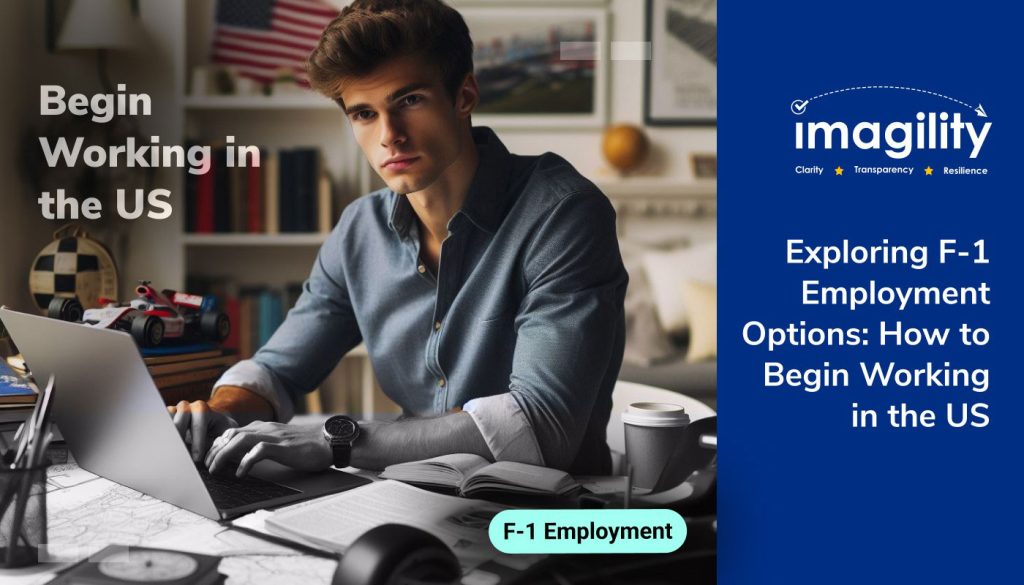Table of Contents
What is the F-1 Student Visa?
Restrictions on Employment
On-Campus Employment
Curricular Practical Training (CPT)
Optional Practical Training (OPT)
Pre-Completion OPT vs. Post-Completion OPT
H-1B Visa Sponsorship
Conclusion
Are you studying in the USA on an F-1 visa and want to explore F-1 employment options? If so, it’s crucial to grasp the complexities surrounding F-1 employment options while pursuing your studies in the United States. Before delving into F1 employment opportunities, it’s imperative to understand certain limitations.
In this blog, we have discussed the various pathways and guidelines for international students on F-1 visas to engage in employment within the United States.
What is the F-1 Student Visa?
The F-1 student visa is a non-immigrant visa designed for individuals enrolled in academic programs in the United States. It allows foreign nationals to study full-time at accredited institutions (SEVP certified) such as universities, colleges, seminaries, conservatories, academic high schools, language training programs, and other institutions.
Restrictions on Employment
Initially, F-1 visa holders are restricted from off-campus employment, with few exceptions. However, students can engage in work opportunities in several ways while maintaining compliance with US immigration laws. Let’s take a look at the below options:
1. On-Campus Employment
F-1 students are eligible to work on campus without special authorization. This includes jobs within the university or college premises, such as library assistants, research assistants, or positions in campus eateries.
However, there are two types of limits on employment if the student tries for on-campus employment. The student must work at school or a place associated with the school curriculum at an off-campus location.
An F-1 student has to oblige to three main employment-related guidelines, which are the following:
- He may work at any on-campus job that does not displace a U.S. citizen or LPR.
- He may work up to 20 hours per week when school is in function (full-time during the periods when school is not in session or during the annual vacation)
- He must report their work to you and receive a certification letter to present to the Social Security Administration to get a Social Security number.
If the F-1 student does not comply with the above guidelines, on-campus employment may be a violation of status that could result in leaving the United States.
2. Curricular Practical Training (CPT)
Curricular Practical Training (CPT) is an off-campus employment option for F-1 students. It allows students to engage in internships, cooperative education programs, or any other type of required internship that is integral to their curriculum. To be eligible for CPT, the employment must be directly related to the student’s major area of study and must be part of the established curriculum. Students must obtain authorization from their Designated School Official (DSO) before starting CPT employment.
3. Optional Practical Training (OPT)
Optional Practical Training (OPT) is another off-campus employment option for F-1 students. It allows students to gain practical experience in their field of study for up to 12 months (or up to 36 months for students in STEM fields) after completing their academic program. OPT can be used for internships, temporary employment, or to kickstart a professional career in the United States. Students must apply for and receive an Employment Authorization Document (EAD) from USCIS to engage in OPT.
4. Pre-Completion OPT vs. Post-Completion OPT
Pre-Completion OPT (Optional Practical Training) and Post-Completion OPT are both valuable opportunities for F-1 visa holders studying in the United States to gain practical work experience related to their field of study.
Pre-Completion OPT allows students to work part-time while classes are in session and full-time during scheduled breaks before completing their academic program. This option enables students to gain experience and supplement their studies while studying.
On the other hand, Post-Completion OPT occurs after the completion of the academic program. It allows students to work full-time in a job related to their field of study for up to 12 months (or up to 36 months for certain STEM fields) following graduation.
Post-completion OPT allows recent graduates to apply the knowledge and skills acquired during their studies in a practical work setting, enhancing their professional development and potentially leading to long-term career opportunities in the United States.
Both Pre-Completion and Post-Completion OPT are subject to specific regulations and requirements set forth by the U.S. Citizenship and Immigration Services (USCIS) to ensure compliance with immigration laws and maintain the integrity of the OPT program.
5. H-1B Visa Sponsorship
Many F-1 visa holders aspire to secure H-1B visa sponsorship, which allows foreign nationals to work in the United States in specialty occupations. However, obtaining an H-1B visa is highly competitive and subject to annual quotas. It’s important for F-1 students to explore this option well in advance and to seek guidance from their academic advisors or immigration experts.
Individuals can use the Imagility H1B lottery app to kickstart their journey to obtain an H1B visa. The app is designed for individuals aspiring to get an H1B visa. Individuals only need to register on the app with basic info, and once registered, they can search for companies willing to sponsor eligible individuals for H1B visas.
Conclusion
Navigating F-1 employment options can be daunting for international students studying in the United States. However, with careful planning and research, F-1 visa holders can explore a variety of pathways for gaining valuable work experience and starting their careers in the US, that includes downloading Imagility’s H-1B Lottery App.
By understanding the nuances of F-1 employment options, international students can leverage their educational experiences in the United States to pursue a rewarding career and lead a prosperous life.
Good Luck!









